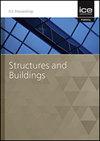Multi-hazard analysis of reinforced concrete structure under blast and post blast fire
IF 1.4
4区 工程技术
Q3 CONSTRUCTION & BUILDING TECHNOLOGY
Proceedings of the Institution of Civil Engineers-Structures and Buildings
Pub Date : 2023-08-15
DOI:10.1680/jstbu.22.00164
引用次数: 1
Abstract
The likelihood of any natural or man-made event preceding a fire is comparatively high, such as a fire occurring after a terrorist attack or any natural disaster such as a tornado, lightning strike, or earthquake. Structure is the one element that is consistent throughout all of these different hazard-fire interactions. In the present study, therefore, the response of a three-dimensional monolithic reinforced concrete (RC) dome structure under explosion loading followed by a fire event is analysed using a detailed Finite Element (FE) analysis in LS-DYNA®. The complete analysis is divided into three stages. Since explosion is a dynamic event whereas gravity loads and fire are considered quasi-static events, explicit and implicit solvers are alternately employed. Material data and equations governing the thermal and non-linear behaviour of RC structure from Eurocode 2 (EC2-2004) are used. Blast load is applied to the dome structure through LOAD_BLAST_ENHANCED whereas, fire load is applied as per ISO 834-10:2014. It is observed that an explosion followed by a fire significantly increases the structural damage. The major emphasis is to understand the behaviour of dome structure under such situations of combined blast and fire loading and showing the capabilities of FEM in these investigations.爆炸及爆炸后火灾下钢筋混凝土结构的多危害分析
火灾发生前发生自然或人为事件的可能性比较高,例如恐怖袭击或龙卷风、雷击、地震等自然灾害后发生火灾。结构是贯穿所有这些不同的危险-火灾相互作用的一个一致的元素。因此,在本研究中,使用LS-DYNA®中的详细有限元(FE)分析了三维单片钢筋混凝土(RC)圆顶结构在爆炸载荷后火灾事件的响应。完整的分析分为三个阶段。由于爆炸是动态事件,而重力载荷和火灾被认为是准静态事件,因此交替使用显式和隐式求解器。材料数据和方程控制的热和非线性行为的RC结构从欧洲规范2 (EC2-2004)被使用。爆炸荷载通过LOAD_BLAST_ENHANCED施加到穹顶结构上,而火灾荷载则按照ISO 834-10:2014施加。可以观察到,爆炸后的火灾大大增加了结构的破坏。主要的重点是了解圆顶结构在这种爆炸和火灾联合荷载情况下的行为,并显示FEM在这些研究中的能力。
本文章由计算机程序翻译,如有差异,请以英文原文为准。
求助全文
约1分钟内获得全文
求助全文
来源期刊
CiteScore
3.40
自引率
6.20%
发文量
61
审稿时长
12 months
期刊介绍:
Structures and Buildings publishes peer-reviewed papers on the design and construction of civil engineering structures and the applied research associated with such activities. Topics include the design, strength, durability and behaviour of structural components and systems.
Topics covered: energy conservation, people movement within and around buildings, strength and durability of steel and concrete structural components, and the behaviour of building and bridge components and systems

 求助内容:
求助内容: 应助结果提醒方式:
应助结果提醒方式:


